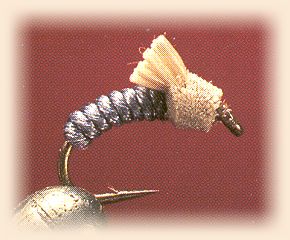The Serendipity
By Skip Morris
This fly was a bit of a mystery to me for some time.
With a bit of snooping, I found that most Oregon
anglers were fishing it dead drift in the surface
film, but then a friend told me, "It's a killer
down deep in the riffles on a dropper system." I
couldn't find a pattern for the Serendipity in print,
but when I perused the fly-fishing catalogs I saw
pictures of flies called Serendipities that varies in
body, head, and wing. Then I heard that the Serendipity
had come out of Blue Ribbon Flies, so I wrote a letter
containing a long list of questions to Craig Mathews
along with an apology for pestering him with so many
questions. Craig was kind enough to answer them all,
and from those answers comes the information that follows.
Ross A. Merigold introduced the Serendipity to Mathews
around 1988. It is generally considered an imitation of
caddis and midge larvae and pupae. It can be tied with
a trimmed-hair head or the hair can be trimmed close and
covered with thread for a thread head (Craig prefers the
former approach), and that is the one that seems to be
winning out. The Serendipity is fished both deep, and up
in the surface film. ~ Skip Morris
Materials List: Serendipity
Hook: Heavy-to-regular wire, regular length, straight or
humped shank, sizes 24 to 14 (the hook shown is a Tiemco 2457).
Thread: 8/0 or 6/0 in a color to match the body.
Body: Z-lon, twisted. Colors include tan, gray, olive,
red, and brown.
Head and Wing: Natural gray deer hair.
Tying the Serendipity
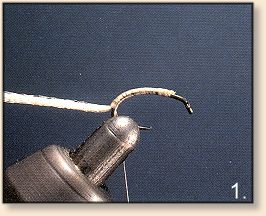
1. Start the thread about two-thirds up the shank. Use the pinch
to tie in the Z-lon. Lift the Z-lon slightly above the shank
under moderate tension, and then spiral the thread tightly down both
it and the shank; continue spiraling the thread down the bend a bit.
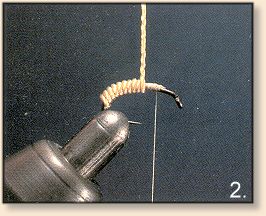
2. Take a few tight turns of the thread, and then spiral it
back to its starting point. Twist the Z-lon tightly
and wrap it up the bend and shank to the thread's starting
point; continue to twist the Z-lon as you wrap it. Secure
the Z-lon with thread turns, and trim the Z-lon's end.
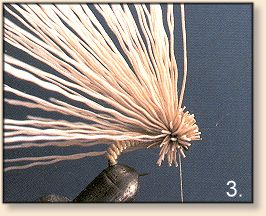
3. Comb a small bunch of deer hair, trim off its tips, and
then tie it in atop the hook at the front of the body using
a light turn. The hairs' butts should project forward. Sprial
the thread forward through the trimmed hair tips; this should
spin the tips around the shank. Just behind the eye, draw the
tips firmly back, and then whip finish the thread and trim it.
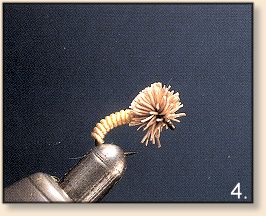
4. Hold the hairs' butts under light tension, slip the tips
of your scissors in, and snip the hairs' butts at a slight
angle as shown, the remaining stubs should be about equal
in length to one-third the body's length.
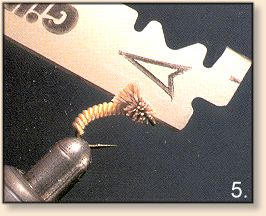
5. Using a razor blade, scissors, or both, trim the hair
butts to a rounded head as shown. If necessary, trim away
some of the butt hairs to leave a neat wing case over the
body. Add head cement to the whip finish.
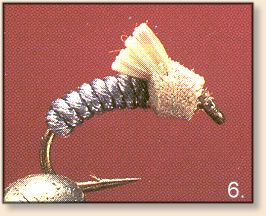
Credits: From The Art of Tying the Nymph by Skip Morris, published by Frank Amato Publications.
|

